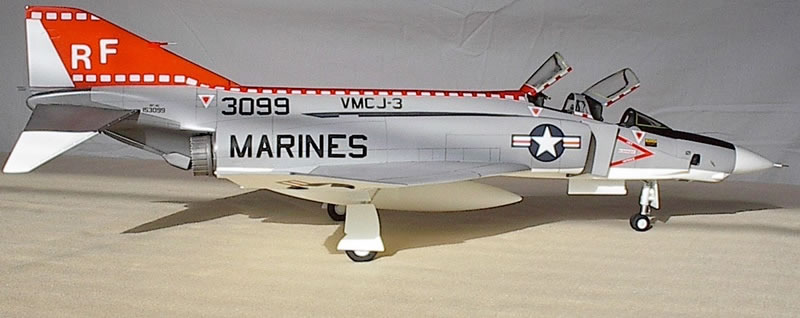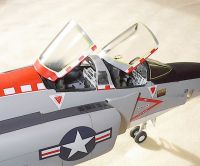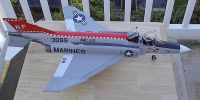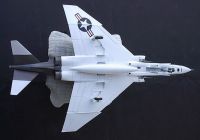Revell 1/32 RF-4B Conversion
By George Piter

RF-4B conversion from the old-mold Revell RF-4B
The title sounds contradictory but the kit is closer to an RF-4E than to an early batch RF-4B. The kit has the thicker wings, fatter tires, and the longer exhaust nozzles of the RF-4E or late manufacture B. It could be built from the box as a late production RF-4B but the beautiful decals the kit comes with are for an early block aircraft with the thin wings and short nozzles. Those decals are what got me started on this project. The paint scheme is colorful and really unique, it wasn't on the aircraft for very long, and there's an excellent photo of the real thing in Jay Miller's Aerofax Minigraph on the RF-4, so I just had to build the thing.
It was definitely a “just for fun” build because to try to fix all of the problems, especially around the cockpit, would be a major undertaking, but I did go ahead and fix some of the more obvious ones. I went as far as modifying the wings to the thinner B wings, modifying the landing gear, shortening the exhaust nozzles, redoing the wheel wells, doing some rebuilding of the cockpit, and replacing the seats. I also built some very basic cameras to go behind the clear windows so the nose wouldn't look empty. The kit was sanded smooth and rescribed after a considerable amount of JB Weld epoxy and Acryl Blue was used to fill seams and reshape and reinforce various parts of the model. The model was given several coats of Plastic-cote automotive primer, sanded with 600 grit, and then a final coat of Tamiya primer was sprayed on and the kit was sanded again with 1000 grit sandpaper in preparation for the color coats. Testors acrylics were used for most of the model and Testors metalizer was used for the rear fuselage and exhaust nozzles. A coat of Future floor wax provided a gloss surface for the decals. After the decals dried the model was airbrushed with Testors acrylic semi-gloss for the finish coat. The Revell decals, in spite of their age, went on well and Solvaset worked well to make them conform to curved areas on the model. Only the RF tail codes had to be replaced because the ones on the decal sheet were too large.
Is it totally accurate? Nope. Does it look like an RF-4B? Yup. Did I enjoy building it? Definitely. Love the scheme. I have another one of these monsters around here somewhere...but I think using a Tamiya F-4C, the Avionix RF-4 nose, and the old CAM F-4B conversion would be easier. Now where did I put that stuff?
© George Piter 2016
This article was published on Saturday, February 06 2016; Last modified on Monday, February 08 2016




